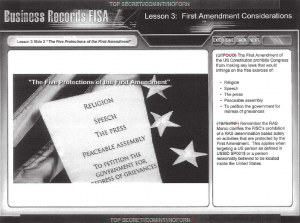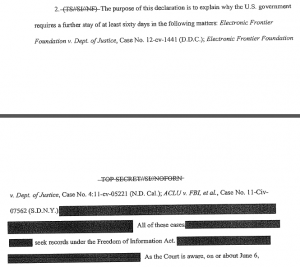Judge Pauley’s Deliberate Blind Spot: Systematic Section 215 Abuses
Sorry for my silence of late, particularly regarding William Pauley’s ruling finding the phone dragnet legal. The good news is my mom can now reach the light switch in her sewing room without risk of falling.
As noted, Judge Pauley ruled against the ACLU in their suit challenging the phone dragnet. A number of commentators have pointed to some bizarre errors or focus in Pauley’s ruling, including,
- Pauley says the government could not find the “gossamer threads” of terrorist plotters leading up to 9/11. They did find them. They simply didn’t act appropriately with them.
- He unquestioningly considers the 3 uses of Section 215 (with Zazi, Headley, and Ouazzani) proof that it is effective. He does not note that even Keith Alexander has admitted it was only critical in one case, one not even mentioned in the government’s filings in this case.
- He ignores the role of the Executive in willingly declassifying many details this program, instead finding it dangerous to allow the ACLU to sue based on an unauthorized leak. The government has actually been very selective about what Snowden-leaked programs they’ve declassified, almost certainly to protect even more problematic programs from legal challenge.
- He claims Congress has renewed Section 215 7 times (including 2001, it was renewed it 5 times).
- He claims there is no doubt the Intelligence and Judiciary Committees knew about the rulings underlying the program in spite of the fact that some rulings were not provided until after Section 215 was renewed; he admits that the limits on circulation of notice in 2011 was “problematic” but asserts the Executive met its statutory requirements (he doesn’t deal with the evidence in the record that the Executive Branch lied in briefings about the conduct of the dragnet).
There are also Pauley’s claims about the amount of data included — he says the government collects all phone metadata; they say NSA collects far less data. This is a more complicated issue which I’ll return to, though maybe not until the New Year.
But I’m most interested in the evidence Pauley points to to support his claim that the FISC (and Congress) conduct adequate oversight over this program. He points to John Bates’ limits to the government’s intentional collection of US person data via upstream collection rather than Reggie Walton’s limits to Section 215 abuses.
For example, in 20011, FISC Judge Bates engaged in a protracted iterative process with the Government–over the Government’s application for reauthorization of another FISA collection program. That led to a complete review of that program’s collection and querying methods.
He then immediately turns to Claire Eagan’s opinion reiterating that the government had found and dealt with abuses of the phone dragnet program.
In other words, for some bizarre reason he introduces a series of rulings pertaining to Section 702 — and not to Section 215 — to support his argument that the government can regulate this Section 215 collection adequately.
It’s particularly bizarre given that we have far more documents showing the iterative process that took place in 2009 pertaining directly to the phone dragnet. Why even mention the Bates rulings on upstream collection when there are so many Reggie Walton ones pertaining directly to Section 215?
I suspect this is because Pauley relies so heavily on the adequacy of the minimization procedures imposed by the FISC, as when he cites Claire Eagan’s problematic opinion to claim that without adequate minimization procedures, FISC would not approve Section 215 phone dragnet orders.
Without those minimization procedures, FISC would not issue any section 215 orders for bulk telephony metadata collection.
(Note, Pauley doesn’t note that the government has not met the terms of the Section 215 itself with regards to minimization procedures, which among other things would require an analysis of the NSA using a statute written for the FBI.)
The only way Pauley can say the limits he points to in his analysis — that NSA can only analyze 3 hops deep, that FBI only gets summaries of the queries, that every query got approved for RAS — is if he ignores that for the first 3 years of the program, all of these claims were false.
He uses similar analysis to dismiss concerns about the power of metadata.
But [ACLU’s contention that the government could use metadata analysis to learn sensitive details about people] is at least three inflections from the Government’s bulk telephony metadata collection. First, without additional legal justification–subject to rigorous minimization procedures–the NSA cannot even query the telephony metadata database. Second, when it makes a query, it only learns the telephony metadata of the telephone numbers within three “hops” of the “seed.” Third, without resort to additional techniques, the Government does not know who any of the telephone numbers belong to.
These last assertions are all particularly flawed. Not only have these minimization procedures failed in the past, not only has the government been able to go four hops deep in the past (which could conceivably include all Americans in a query), not only is there abundant evidence — which I’ll lay out in a future post — that the government does know the identities of at least some of those whom it is chaining, but there are two ways the government accesses this data for which none of this is true: when “data integrity analysts” fiddle with the data to prepare it for querying, and when it is placed in the “corporate store” and analyzed further.
All the claims about minimization Pauley uses to deem this program legal have big big problems.
The NSA conducted a fraud on the FISC for 3 years (and still is, to the extent they claim the violations under the program arose from complexity rather than their insistence on adopting all the practices used under the illegal program for the FISC-authorized program). Yet Pauley points to the FISC to dismiss any Constitutional concerns with this program.
And to do that, he ignores the abundant evidence that all his claims have been — and may still be, in some cases — false.


